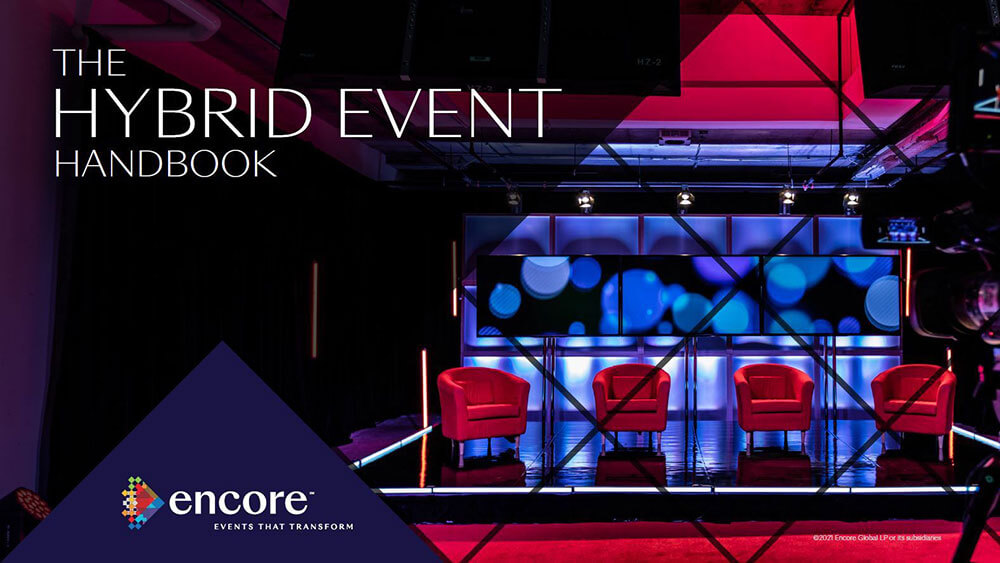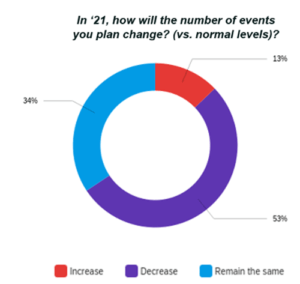
The Hybrid Event Handbook, Encore’s guide to delivering a successful hybrid program, is based on the company’s 12-plus years of experience producing virtual and hybrid events.
As of Jan. 11, 2021, PSAV and its family of companies have formally rebranded as Encore. The move unifies operations of its global family of companies, but more importantly it restores the company’s mission — delivering an end-to-end suite of creative, production, and technology services to organizers of business events.

“We now have an entirely new visual identity that signals a forward focus in a world changed by a pandemic,” said Encore president and CEO, Ben Erwin.
Encore’s research from surveying more than 2,000 industry professionals last year reveals that hybrid events will be a predominant format. However, very few of them have experience planning this type of event, and even find the prospect daunting. So Encore has been working on suite of hybrid event solutions, starting with “The Hybrid Event Handbook.” The initiative builds on MeetSAFE ™, a program Encore launched in early 2020 to help the live event industry safely adapt to the changing meetings landscape, to provide a clear roadmap for planning a hybrid meeting, regardless of size. To achieve this, Encore advises to focus on six key drivers — environment, experience, engagement, creative, content, and production. Read on for a detailed breakdown of each.
Environment
Create a purposeful meeting space for both in-person and remote participants. For the former, work with the venue team on room arrangement, staffing, physical safeguards, and other factors to mitigate risk. Consider how to keep in-person attendees engaged with presenters, no matter where they are in the room, as well as the impact lighting, décor, ambient noise, and other elements may have on the virtual experience.

When Encore asked planners if the number of events they planned to execute in 2021 would change, only 34 percent said no, while 53 percent said the number would decrease.
Experience
Aim to keep the audience engaged — regardless of how they’re tuning in. To keep participants focused on the content, understand what’s important to each stakeholder and what motivates them to attend in the first place. And manage expectations — not just of attendees, but also of presenters and sponsors. Communicate what they can expect so that they can decide whether to attend in-person or remotely.
Engagement
Engaging content is made possible through the engagement tools available in an event platform. Aside from video playback and chat, organizers should look at ways to incorporate polling, voting, surveys, and other collaboration tools — and also test them ahead of time. Take advantage of virtual downtime to host networking events, happy hours, or games to allow people to process the information they’ve gained.
Connectivity
A stable network is critical. In addition to ample bandwidth at the venue, it’s also key to have reliable on-site tech support. And although there is little an organizer can do for a remote attendee’s dodgy connection, it’s helpful to push out tips to them ahead of time, including:
- Plug your computer directly into your router to remove any Wi-Fi unpredictability
- Ask others in the space to avoid livestreaming at the same time
- Use a tried-and-true headset that limits ambient noise
Content
Production
Traditional live event production (audiovisual services) combined with digital expertise delivers unmatched impact. But success hinges on a deliberate approach — developing and adhering to a project timeline, aligning the overall vision with stakeholder needs, and remaining conscious of competing priorities, and time zones. Develop a project timeline by mapping out these areas and all of the components that will require production support.
To collaborate with Encore, reach out at (866) 351-1144.

